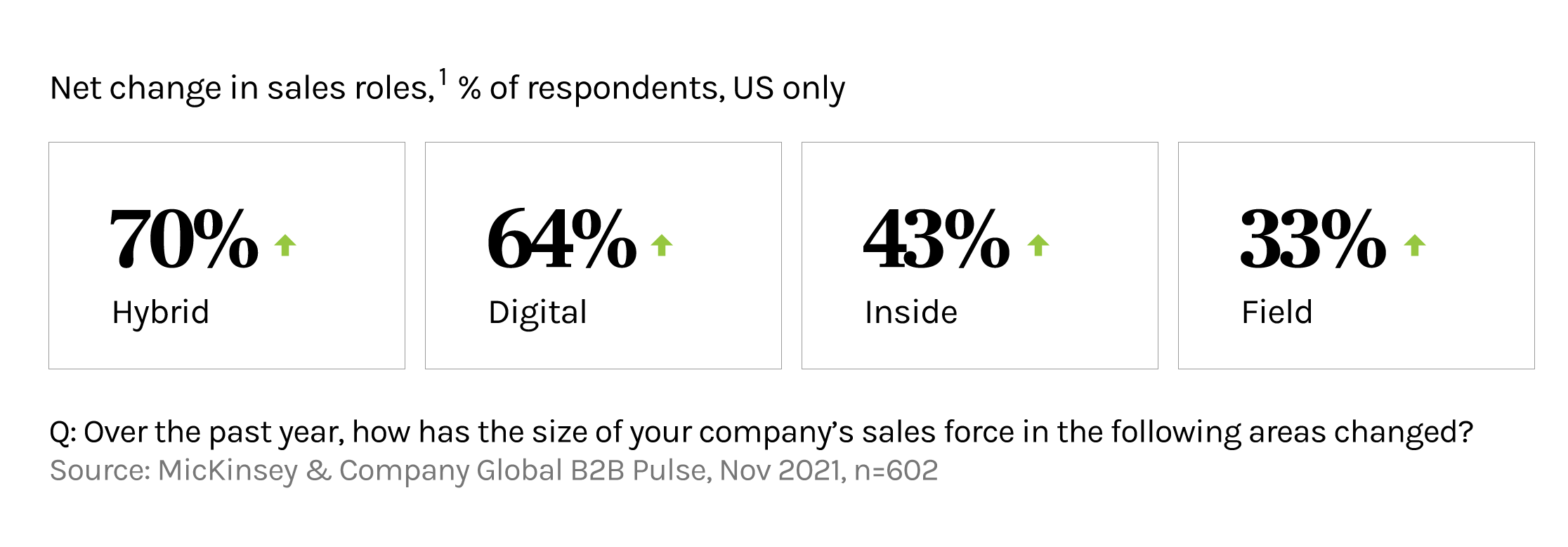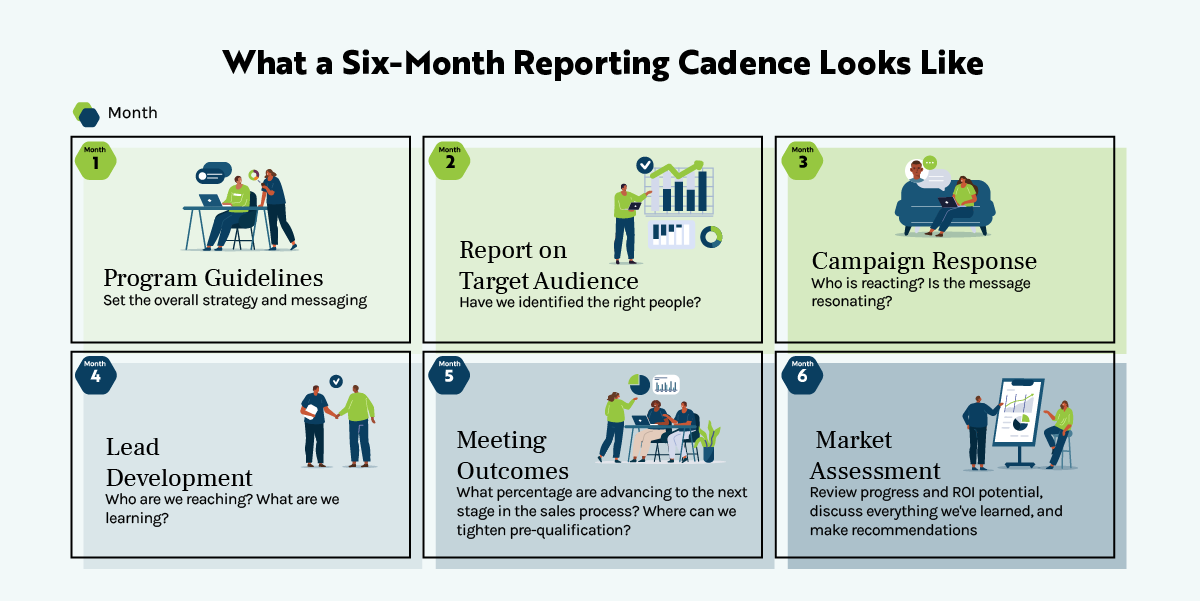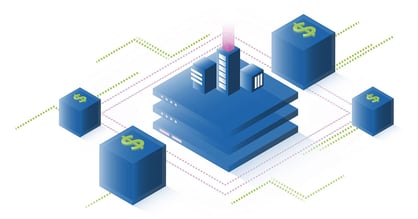Whether you have an in-house team or use a partner like MarketLauncher to fulfill the inside sales role, both inside and outside sales need to work hand-in-hand if you want to turn leads into the right sales opportunities. Together, two teams aligned to the same goals can achieve more wins.
According to our partner, HubSpot, Inside sales refers to the process of selling remotely via phone, email, and other digital channels, instead of face-to-face, which outside sales reps perform. It’s popular in the B2B space, particularly in SaaS and tech industries.
Inside sales teams are comprised of specialists focused on top-of-funnel prospecting. These specialists work to convert leads from both inbound and outbound efforts into sales opportunities. Your marketing team should create market awareness and drive inbound leads by attracting the attention of buyers who are actively looking for solutions to a problem. Meanwhile, a targeted outbound effort driven by the inside sales team will accelerate your exposure to target accounts by putting your message in front of potential buyers at every stage of the buying cycle.
Outside sales or field sales refers to professionals who focus on the opportunities that are most likely to move forward to a close. They often meet prospects in-person, share their knowledge, and position themselves as a trusted adviser. Then, they guide the prospective buyer toward a solution.
The difference between inside sales and outside sales is where they focus efforts in the sales funnel. Inside sales reps work at the top of the funnel to identify new prospects and develop them into leads that progress further into the funnel. Outside sales reps are focused on the bottom of the funnel to turn sales opportunities into new clients.
The first step in building a sales pipeline is top-of-funnel prospecting. Inside sales use both inbound and outbound marketing efforts to generate those leads.
Outbound marketing identifies target accounts that meet your ideal client profile. A strategic outbound effort allows you to accelerate your exposure to these target accounts by putting your message in front of potential buyers at the early stage of the buying cycle, rather than waiting for them to find you.
Inbound marketing is a digital approach to building brand awareness and generating leads. An inbound strategy drives inbound leads by attracting the attention of buyers who are actively looking for solutions to a problem.
Inside sales reps make phone calls and send emails to start the dialogue. These conversations are necessary for assessing needs, challenges, and purchasing power.
Inside sales reps determine if they have identified the right person and ask questions to qualify a prospect.
Once the right opportunities are identified and teed up to enter the sales cycle, the outside team steps in and works to move the opportunity forward and close the deal.
No matter how you structure your sales team to manage these two functions, they need consistent collaboration to keep the wheel spinning.
The quick pivot to digital communication in 2020 accelerated the shift in buyer behavior that began in 2016. Outside sales reps needed to quickly adapt to effectively add digital communication tools to their arsenal. These tools included video conferencing and online chats. In a 2021 Mckinsey survey, B2B customers began favoring video conference interactions with sales reps.
“The pandemic accelerated the move already under way to omnichannel and e-commerce, and survey respondents indicated that the change was here to stay.”

The emergence of hybrid roles on a sales team reinforces the need for an omnichannel approach that includes inside sales, outside sales, and self-service e-commerce portals. According to the same study, 94 percent of B2B decision-makers prefer the new normal of omnichannel sales.
B2B buyer behavior will continue to evolve. Your sales team must stay up to date with that evolution. You can help your sales teams achieve their full potential by following our sales rules of engagement between inside and outside sales.
Real-time collaboration is key to sales team alignment. Most of the time, inside and outside sales teams do not work face-to-face, but they should always operate like they're just a desk away. As inside sales are making headway on inbound leads, they need a place to share details about their conversations. This will allow the outside sales team to offer additional insight to move the sale forward.
There are many resources that support real-time communication. For example, we use Microsoft TEAMS which gives our clients real-time access to their MarketLauncher team. We share insights, ask questions that come up as we have conversations, and share the news when we've converted a hot lead. There are other effective tools on the market that serve this need including Zoho Connect which featured an interview with our CEO, Lara Triozzi in 2017.
If you want your teams to join forces, they must work towards the same goal. That includes a firm understanding of the criteria to qualify opportunities. These factors can include buying authority, pain points, timing, company profile, or relevant corporate initiatives. They might differ by target organizations or even by your different offerings.
By having a firm definition of qualification criteria, the inside sales team will know whom to convert to a productive first meeting and whom to nurture until later when the factors are more aligned.
Ask the outside sales team to give you two or three of the most important data points they need before a first-stage sales meeting. This will help keep the inside team focused on what is most important and open the door to a meaningful conversation about how your company can solve a prospect’s problems.
You will want to agree on the lifecycle of a lead and when to convert it to a sales opportunity. More strategic sales require talking to prospects early in the buyer journey, identifying an unmet need, and educating the buyer about potential solutions.
In other cases, an outside sales rep might not need to step into the process until the prospect is further along and ready to buy. When these differences are defined at the beginning, the inside sales team will know when to pass along a lead to the salesperson at the right time.
For example, MarketLauncher usually handles the entire inside sales function -- from building the audience to qualifying decision-makers and booking appointments for outside sales.
In most cases, our clients want to engage with prospects who are warmed up and ready to move forward. Sometimes this means converting a prospect looking for a solution and ready to buy. Other times, it means creating an early-stage introduction with a verified decision-maker at a target account. Our team knows in each scenario when to move a lead forward so we can integrate seamlessly into our client's sales process.
The greatest danger in lead development is ending up with a messy pipeline full of leads that have gone dormant. At MarketLauncher, we refer to that as the "black hole of forgotten leads." Keeping your prospect data clean and your pipeline healthy requires cooperation from both sides of the sales team.
Think of it as a feedback loop. Inside sales reps warm up the prospect for outside sales. If the contact goes dark, they should be passed back to the inside team to nurture and re-engage later.
Inside sales should gather more intel on what might be needed to move the dark leads forward. Some decision-makers need more time and engagement. Others may have moved forward with a competitor. Never abandon a lead because they haven't made progress in your sales cycle.
You'll see the most success when you can ensure your sales executives focus on the opportunities most likely to move forward while ensuring other leads receive attention from the inside sales team until they convert.
A consistently flowing feedback loop means your sales team will know what is real when looking at their pipeline and actively work on the next steps with each other's support.
Effective sales team alignment must also include visibility and transparency for everyone.
You should schedule regular meetings to check in on KPIs and optimize your strategy at least every quarter, if not every month.
Reporting will be compromised if sales reps save their notes and status updates on disparate systems. First, develop a systematic process that keeps all data on your CRM, so you have real-time and historical data to analyze. Then, bring both sides of your sales team together to see how the metrics are performing and strategize what needs to happen to hit objectives.

This is what our reporting cadence during a six-month ramp-up looks like at MarketLauncher:
While each month focuses on a different benchmark, these discussions are happening throughout the campaign, and additional strategy sessions can be set whenever something new comes up. Often, our clients come to us mid-campaign with a new offering to share, a target market or location to focus on, or a marketing campaign that needs follow-up. Setting clear goals and objectives is critical, but an inside sales team must be flexible to shift with market and buyer needs.
Qualifying leads and closing deals require two very different skill sets, and data that covers the entire lifecycle of the opportunity. Getting a prospect from the first conversation to a closed deal can take dozens of touchpoints and months of nurturing, especially if it is a complex sale.
Outside sales are typically more focused on moving deals through to close. They do not have time for prospecting. Inside sales should step in to ensure early-state opportunities aren’t ignored.
MarketLauncher clients know they will have a steady stream of net new opportunities consistently entering the pipeline, allowing the outside sales team to be more strategic with their time. It is vital to have a skilled team focused on managing the top of the funnel so the outside sales team can focus on winning new business. As a unified front with an aligned purpose, an inside and outside sales team that is fully aligned can achieve a predictable growth model and bring new firepower to your pipeline.




